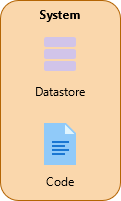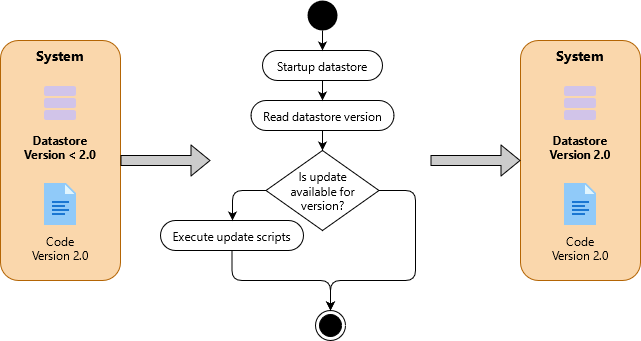Micro migration
When you think about default database setup, you probably imagine something like this:
Yet in reality most workflows involve different systems like test systems and prodution systems. In code this workflow is represented with version-control systems and different branches.
For this code workflow to behave correctly, for each system a seperate datastore is needed. To keep these datastores to represent the correspondend data for the code is a hassle.
That's why migration frameworks like Flyway and Liquibase exist. Unfortunately both these frameworks are designed to support any type of SQL databases but no NoSQL databases like MicroStream. This led to the creation of this library.
This library delivers an easy concept to keep your MicroStream datastore versioned with migration scripts written in plain java. It's easy to create code, that automatically brings an datastore with an older version to the version, suited to the current code.
Approaches
There are two possible usages with the Micro migration library:
The first, easier approach is to use the MigrationEmbeddedStorageManager.
It can be used on a brand new datastore or introduced later, after a MicroStream datastore is already in use.
Only the storage manager (MigrationEmbeddedStorageManager) knows about the versioning.
The rest of application does not know about the version and can have no regards about it.
MigrationEmbeddedStorageManager
Extensive examples can be found in its own repository.
A simple example where scripts need to be registered in the ExplicitMigrater:
public static void main(String[] args)
{
ExplicitMigrater migrater = new ExplicitMigrater(new UpdateToV1_0());
MigrationEmbeddedStorageManager storageManager = MigrationEmbeddedStorage.start(migrater);
//Do some business logic
storageManager.shutdown();
}The update scripts can look like this:
public class UpdateToV1_0 implements MigrationScript<Object>
{
@Override
public MigrationVersion getTargetVersion(){
return new MigrationVersion(1);
}
@Override
public void migrate(Context<String> context)
{
//Logic of the update
context.getStorageManager().setRoot("Update 1.0");
}
}MigrationManager
Although the approach with the MigrationEmbeddedStorageManager is pretty easy to handle, it is intrusive
in the way, that it replaces the root entry point of the MicroStream datastore and inserts its own VersionedRoot as root. Some users might find this too entrusive.
That's why a second approach can be used, where the MigrationManager is used. This class is also used internally by
the MigrationEmbeddedStorageManager.
public static void main(String[] args)
{
ExplicitMigrater migrater = new ExplicitMigrater(new UpdateToV1_0());
EmbeddedStorageManager storageManager = EmbeddedStorage.start();
VersionedObject<Object> versionedRoot =(VersionedObject<Object>)storageManager.root();
new MigrationManager(versionedRoot, migrater, storageManager).migrate(versionedBranch);
//Do some business logic
storageManager.shutdown();
}Migrater
ExplicitMigrater
Scripts for the migrations must be registered in a MicroMigrater.
The simplest way for this is to use the ExplicitMigrater and just put the scripts in the constructor.
A downside of this method is that you need to register all scripts (new or old) manually in the constructor.
final ExplicitMigrater migrater = new ExplicitMigrater(
new UpdateToV1_0(),
new UpdateToV1_1()
);ReflectiveMigrater
For a more convenient usage the ReflectiveMigrater was built.
You simply instanciate a object of this class with the package name of your MicroMigrationScripts.
The ReflectiveMigrater will search for any implementations of MicroMigrationScript in the given package.
This way scripts can simply be placed in the same package and on startup of the application all scripts are loaded in.
final ReflectiveMigrater migrater = new ReflectiveMigrater("de.johannes_rabauer.micromigration.examples.reflective.scripts");Since the ReflectiveMigrater uses the Reflections library it is extracted to its own repository.



